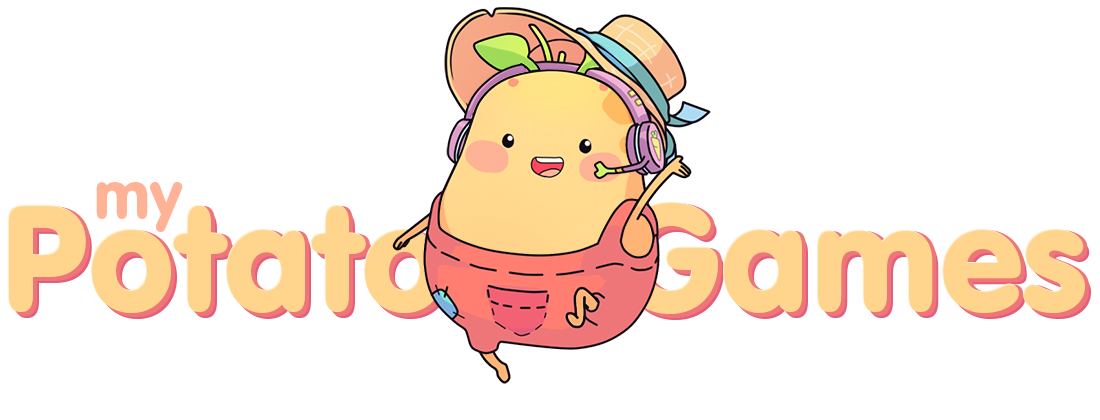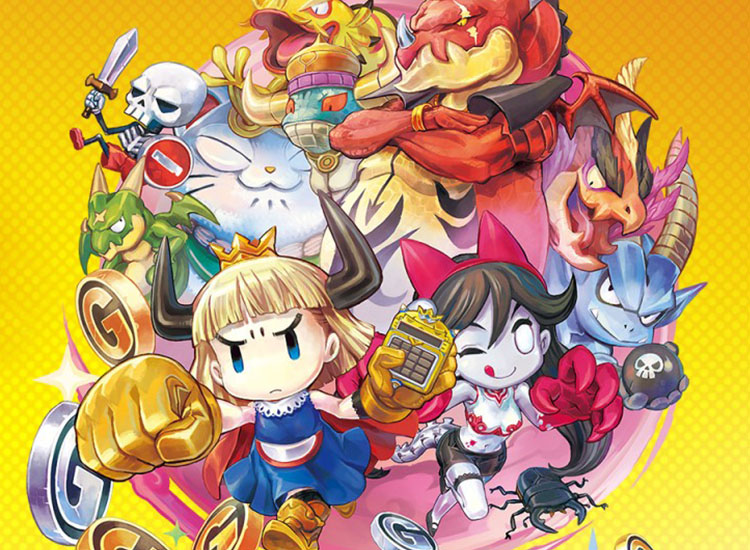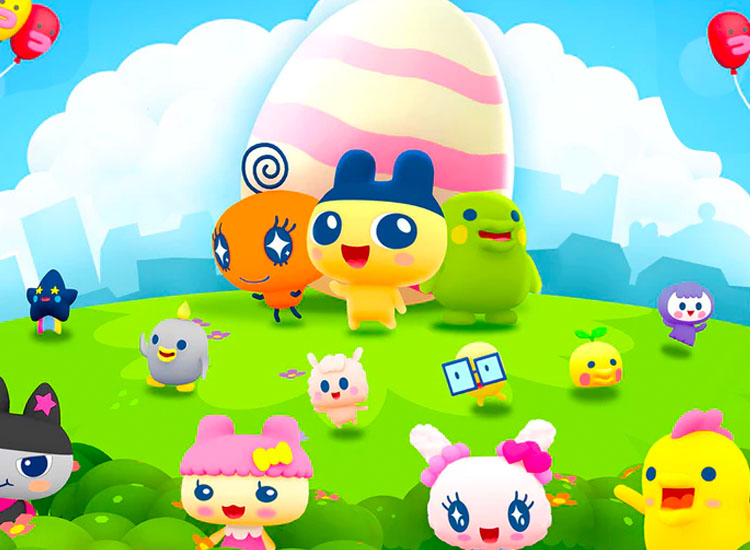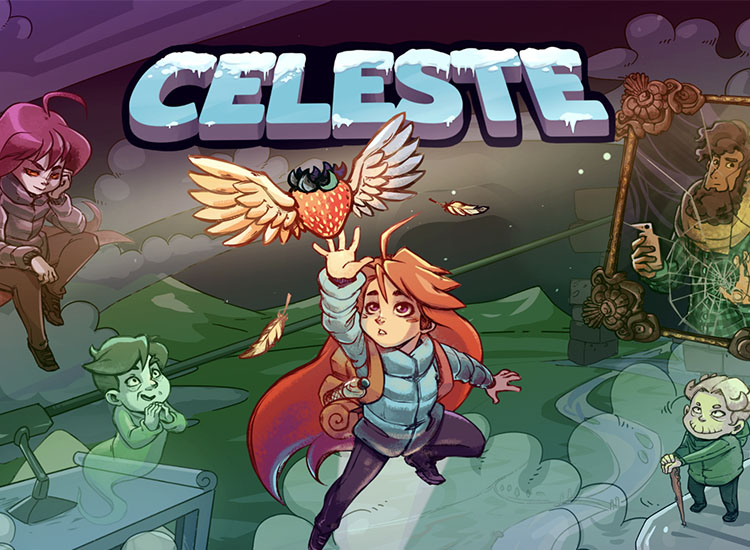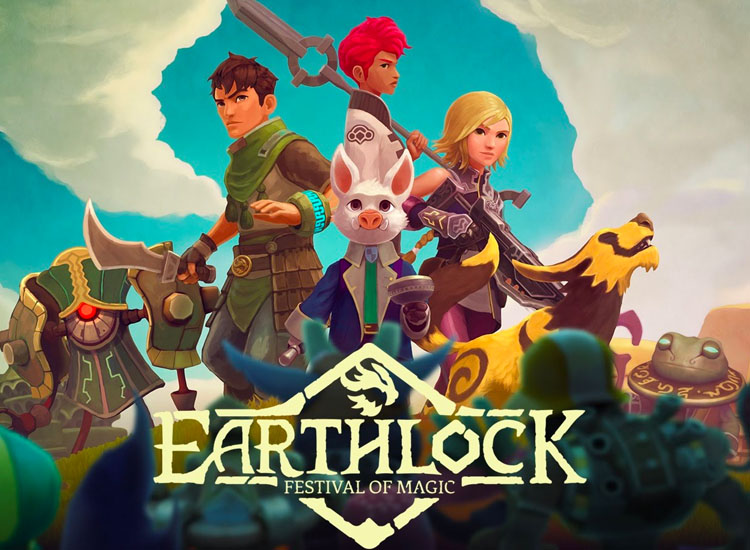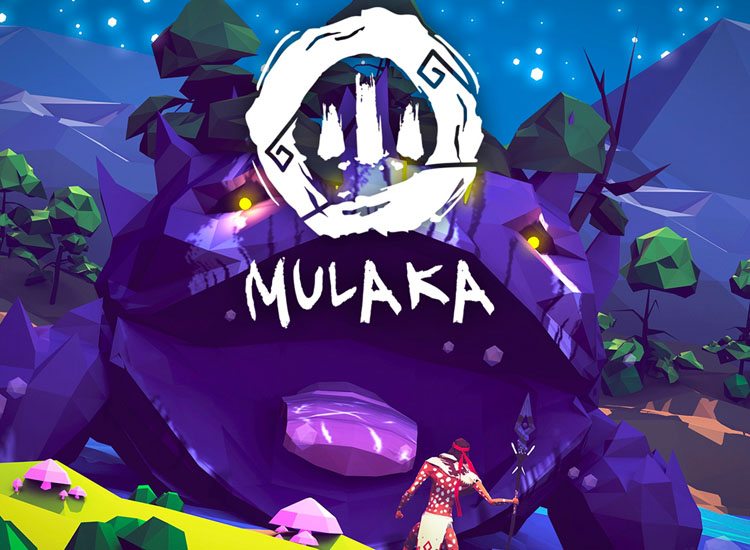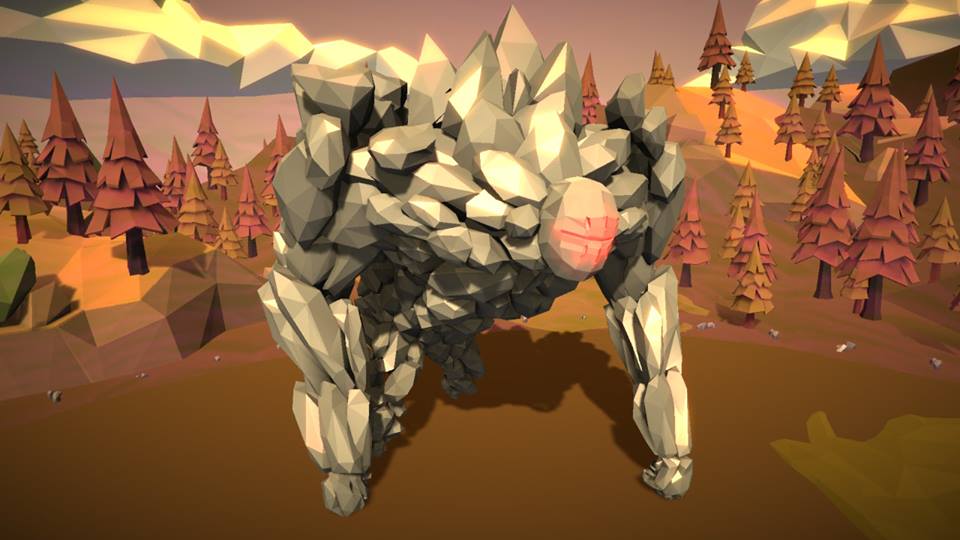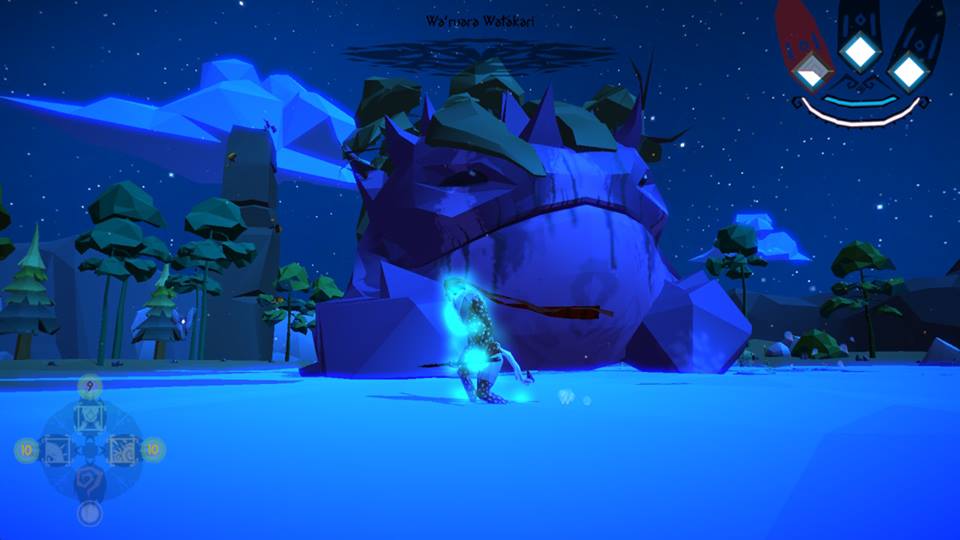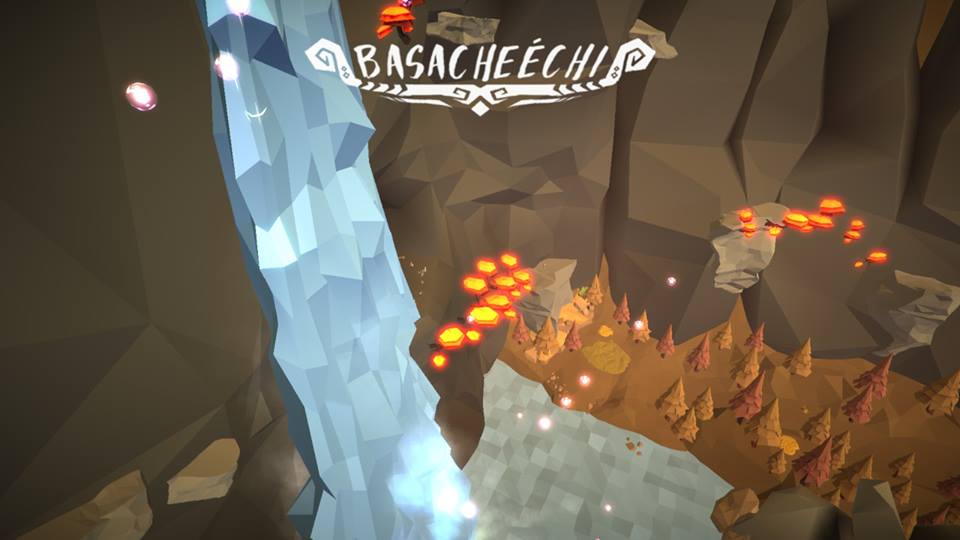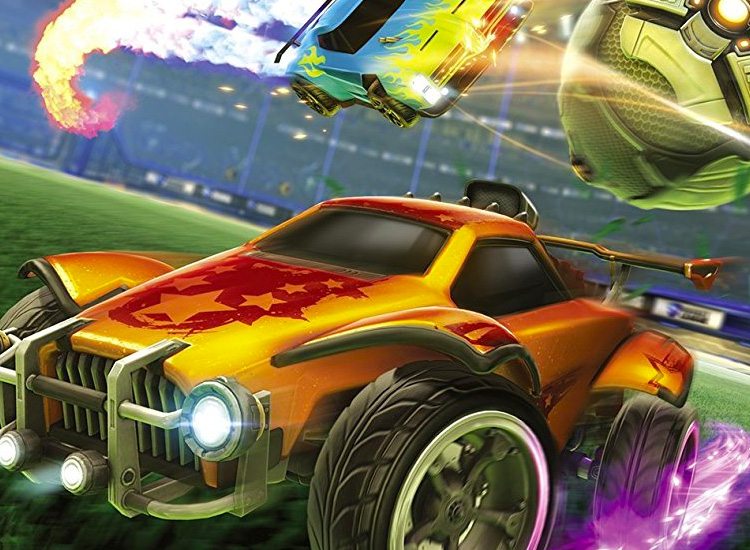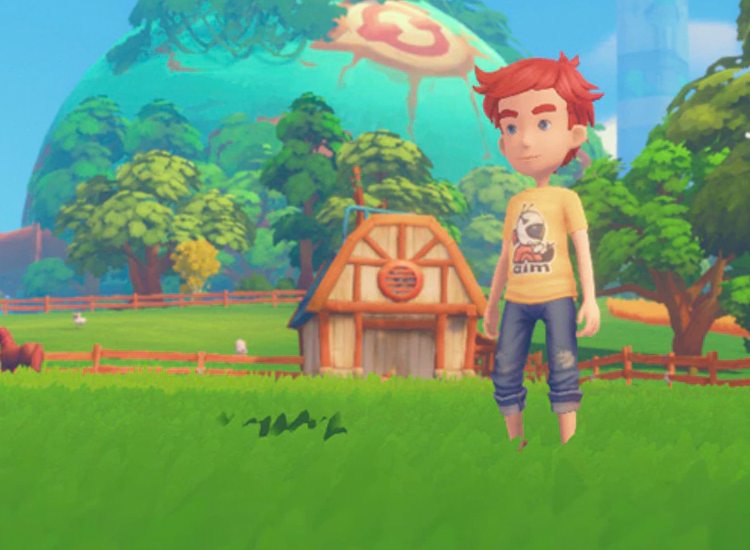Reviews
- Home
- Reviews
Apr 13, 2018News
In the world of Penny Punching Princess, money is everything. In the past, physical power meant everything, but as the time’s changed, so did the people. Capitalism took hold of the world and money quickly became the answer to everything. This premise sounds particularly dark and dismal, yet somehow Penny Punching Princess manages to be a cute and colorful beat em’ up/role-playing game hybrid, that pairs an odd yet charming story, with amazingly addictive gameplay.
The story of Penny Punching Princess centres on the titular money-hungry Princess and her stag beetle butler Sebastian, as they journey to avenge her father by taking down the Dragaloan family, a devious bunch who tricked her father into investing all his money into their mutual funds and foreign exchange, which lead to debt and his death. If you think that sounds absolutely bizarre, you wouldn’t be wrong. The narrative on display isn’t afraid to be outlandish, which leads to a story that is rather silly and enjoyable. The story is aided by its brilliantly executed translation, which was done by NIS America, with the dialogue exchanged between characters being hilariously written. The character interaction in the story is told between levels through simple text box cutscenes, accompanied with the characters and their bobbing heads. Although the simplistic cutscenes are quite cute and not inherently bad, I wish there was more effort put into them, such as voice acting for all dialogue, or more impressive cinematics. It’s a minor gripe nonetheless, as I still enjoyed what the silly story had to offer.
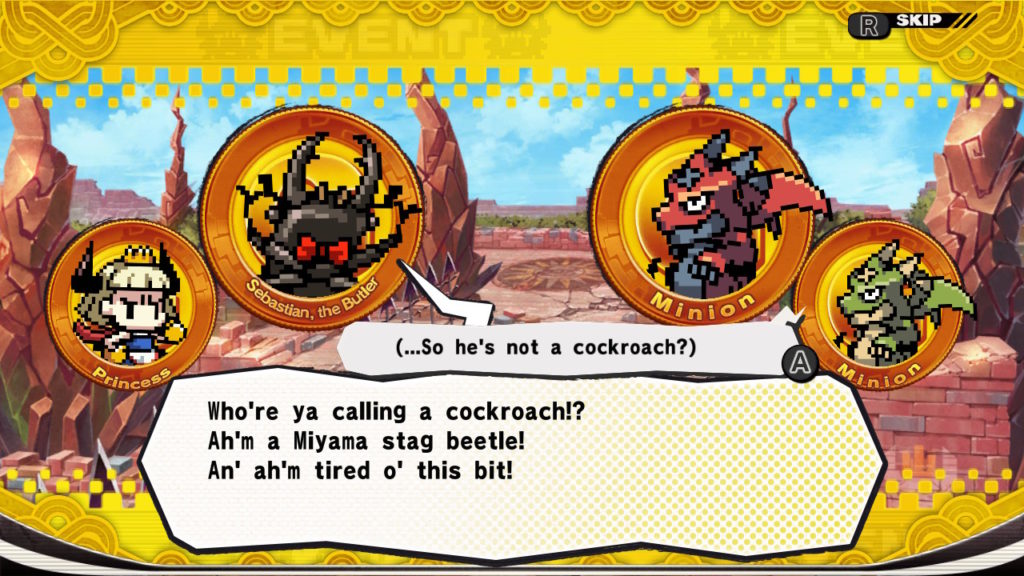
The writing on display is both charming and entertaining
The gameplay in Penny Punching Princess is undoubtedly the strongest component of the game. Each level has you tasked with taking out hordes of enemies in order to reach the end of the level. How you deal with the enemies however, is up to you. You have the physical attacks of the princess, such as a light punch or a heavier punch that can be charged in order to do more damage, as well as the greatest weapon of all, a magical calculator.
As previously mentioned, money means everything to those in the Capitalist world of Penny Punching Princess, so much so, that the enemies hell-bent on taking you down can simply be bribed into helping you. Money is power, after all. Bribing obviously requires money, so you won’t always have the ability to do so, meaning you must plan efficiently when to spend your money, and how much is wise to spend.
Enemies aren’t the only thing that can be bought by money. The Environment around you can be purchased to aid you also, such as fire breathing statues and spike traps. You can even pay off doors that allow access to loot you otherwise wouldn’t have been able to obtain. The fact that almost everything can be paid off except the end of world bosses is awesome, as it allows for variety in how you approach each level. If you’re keen to try your luck you can bet a cash amount of your choosing and try the coin miracle option, which could possibly reward you with some health or more money. There is a surprising amount of depth to the calculator mechanic, and despite it being rather simplistic in its execution, it’s an extremely unique and fresh idea that I enjoyed tinkering with.
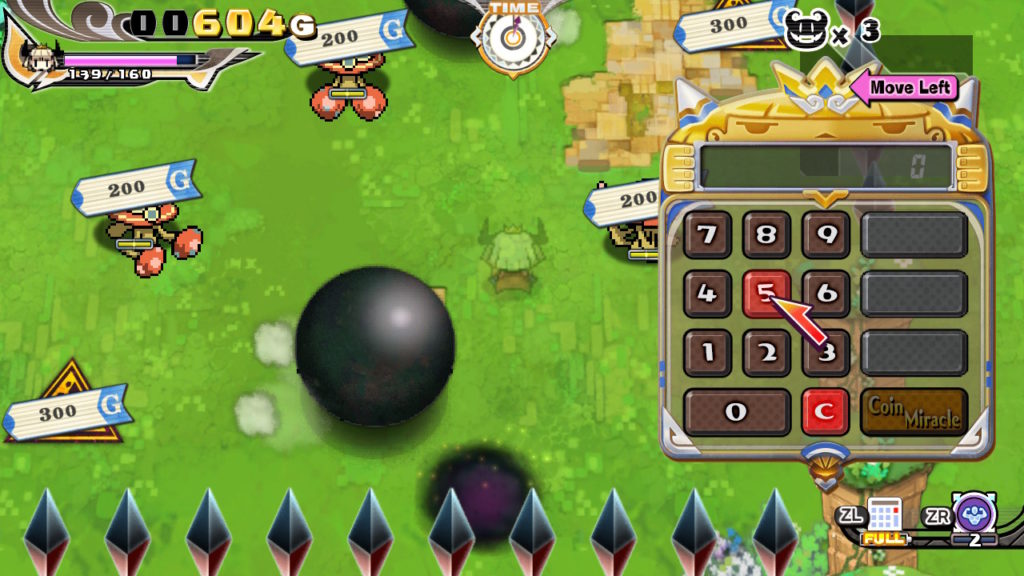
The freedom to bribe whatever you like allows for multiple approaches to each level
The Princess can also obtain upgrades by acquiring Zenigami statues from the golden chests in each level, which act as the games skill points currency. The skill points awarded for the collection of each statue allow for upgrades such as new attacks for the princess, more money dropping from enemies, as well as the expected health and attack upgrades. Despite not requiring much effort to find, locating Zenigami statues in each dungeon feels remarkably rewardable and satisfying. Zenigami statues can also be crafted, as well as armor, that come with certain buffs and effects. In order to craft said items, you must collect a certain amount of particular types of enemies, which means there is some grinding required at times. The grinding in order to craft statues or armor never feels too egregious, but it can often hinder the flow of the game.

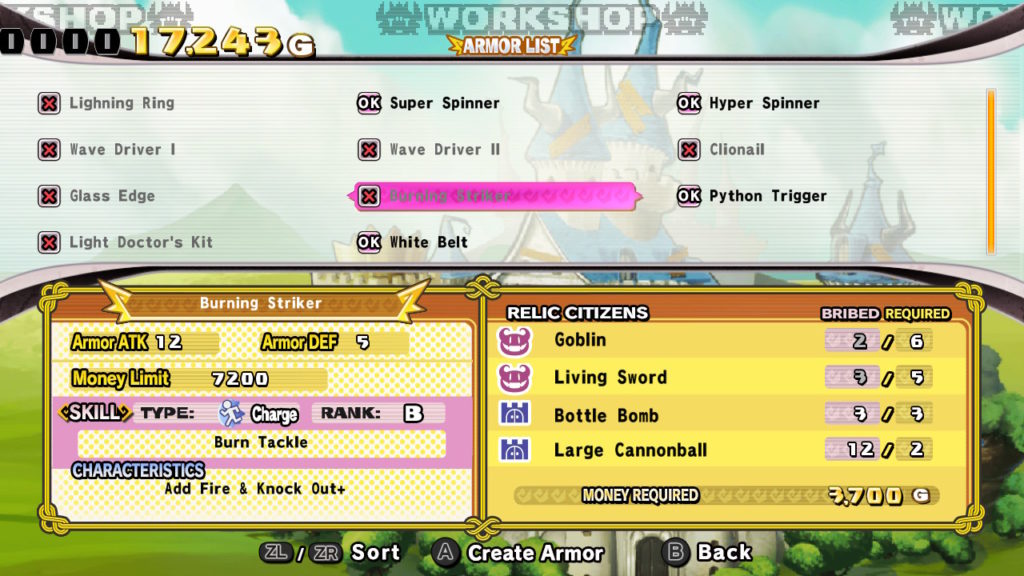
Bribing certain enemies and environments unlock armor upgrades for you to purchase
Despite the calculator being the most unique and exciting mechanic in the game, it does have a couple of shortcomings regarding its use. The calculator most of the time isn’t too difficult to use, but when in fights against plenty of enemies, it can be rather finicky trying to input the right cash amount and pick the ideal target to bribe. As you get more proficient with the controls, it becomes easier to juggle both dodging enemies and using your calculator, but it can be frustrating at times, especially when you overpay an enemy that you weren’t trying to bribe in the first place.
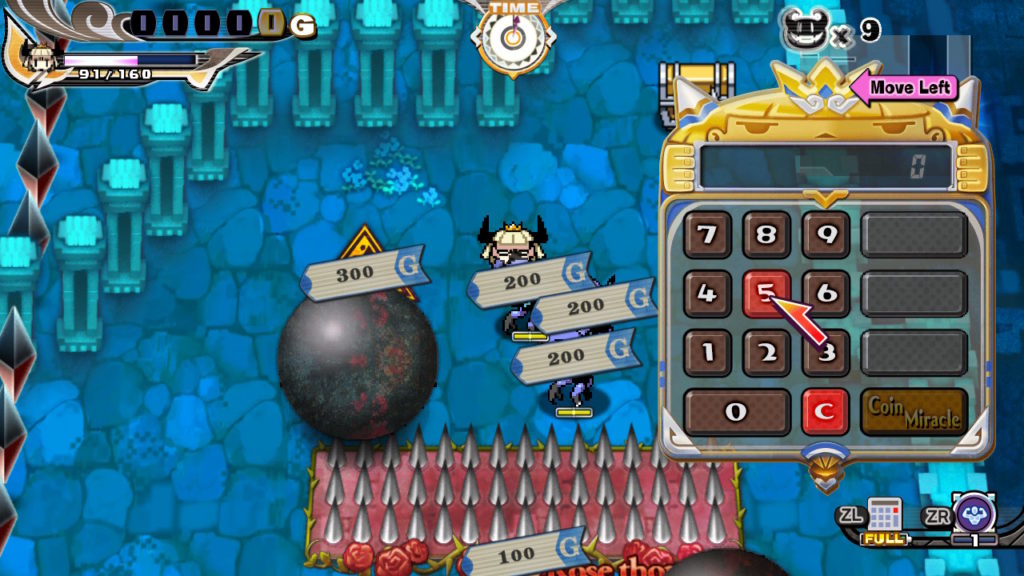
Using the calculator effectively in busy fights proves difficult
The biggest issue I had with the game however was the difficulty spikes. The difficulty often ebbs and flows, meaning that some levels will be an absolutely cakewalk, while others will be so difficult that you’ll be left to churn through already beaten levels numerous times in order to gather the resources to better upgrade your character. The difficulty of the game at times can often feel rather unfair, which is further compounded by the sparse checkpoints throughout each level. It’s never fun having to beat an area you’d already beaten 5-10 mins before dying again and again. These issues ultimately disrupt the games flow, which is definitely an annoyance, but if you can make it through some annoying moments there is plenty of fun to be had.
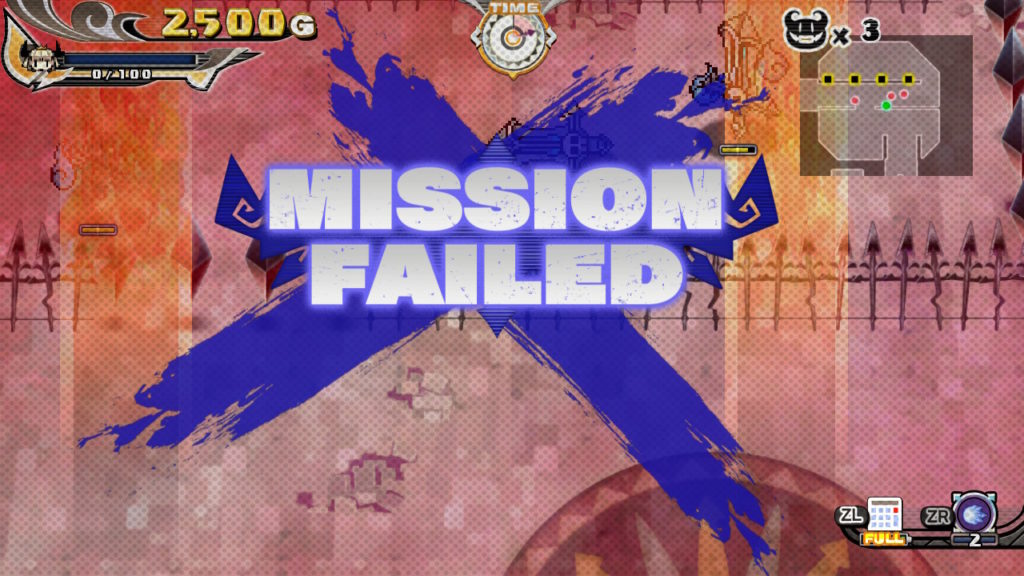
You will see this death screen plenty of times
Penny Punching Princess provides an extremely addictive experience. The narrative is ridiculous yet somehow rather amusing, the same of which can be said about the cast of characters, who all exhibit humorous writing that keeps the task of reading dialogue entertaining rather than monotonous. The gameplay of traversing dungeons, collecting coins, finding chests, and killing/bribing the multitude of enemies along the way is an extremely satisfying gameplay loop that remains enjoyable throughout the variety of chapters, albeit being derailed occasionally by the unpredictable difficulty spikes. Pair the aforementioned elements with a brilliant soundtrack and beautifully colourful visuals, and you’ve got yourself an awesome beat ‘em up RPG that is destined to keep you entertained for hours. Despite having some minor issues in regard to difficulty spikes and grinding, Penny Punching Princess is a thoroughly delightful experience that I implore everyone to try.
Big thanks to NIS America for providing the review copy of Penny Punching Princess on Nintendo Switch.
Mar 31, 2018News
I was one of the many people who heard the rumors, the quiet mutterings: Tamagotchi is going to have an app game. I waited with bated breath for what felt like forever and then? The app came out, seemingly out of nowhere. I’ve compiled, what is probably combined, hours into this app and I’m still not bored. But how? Tamagotchi is such a simple concept. How could an adult with a busy life still be playing such a simple app game almost a week later and not be bored. It’s a rough combination of nostalgia, which that’s to be expected, and also oddly enough the fluidity of the way the game runs.
Gameplay
Bandai Namco did something right, that’s for sure. If this game has anything going for it, it’s definitely the way it seamlessly integrates itself into your day to day life. Sometimes I don’t even realize I’ve played it multiple times in one day until it’s brought to my attention. Just like the original Tamagotchi, you care for a baby, then a toddler, teen, and then an adult. Once the cycle is finished you start the whole process over again. My first tama took less than a week to fully transform. The game does have something that I wish the other games had. Before you send your adult tama on their merry way to do whatever it is they do, they have a dream career. You help them along their way to that career by playing mini games and getting the uniform outfit for that career. I think this is a welcome addition to vintage Tamagotchi gameplay and is super cute. I felt much more of a connection to the adult form afterwards. You also fill pages full of specific pictures on playground equipment. This is what you will spend the bulk of your coin currency on. Filling up a page unlocks rarer outfits.
Basic care
When in baby form, which only lasts a few hours, they will push notifications to you to be fed every 15 minutes or so. Once they hit toddler form, they won’t need as much maintenance. I’m on edge about how I feel about this. On one hand, it’s similar to taking care of an actual baby animal. On the other, it breaks the flow of gameplay integrated into your daily life. So if you don’t mind babying your app a few hours every week, this could be a plus for you.
Care consists of happiness, hunger, cleanliness, bladder, and sleep. Happiness is pretty straightforward. You can fill their happiness meter by petting them for about ten seconds or play a mini game. Happiness is low on the priority list compared to other care meters and your tama will not allow you to maintain your happiness meter until other red meters are taken care of. Hunger is second on the priority list. Your tama will tell you what it’s craving. As far as I have noticed, by all means correct me if I’m wrong, giving your tama what they are craving does not do anything for XP or happiness. Sleep is tied for a second on the priority list with hunger. When your Tamagotchi sleeps, it can take upwards of a few hours, depending on age. You can use gems or watch a short ad to immediately refill the meter, however, if you need to maintain your other meters as well. Bladder is ultimately the most important priority for your tama. It’s a simple bit of button mashing to get them to go to the bathroom and refill their meter. If you don’t get to your app quick enough, your tama will poop everywhere and become dirty. You will need to clean these up and give your tama a bath which brings us to the next factor in care. Cleanliness is maintained by bathing and for whatever reason does not have a meter. I suppose how dirty your tama looks is a meter in itself. You soap them up and then shower them. Care is simple, just like the keychain games.
Mini games
You have a match three game, planet jump, band practice, and a game called “hide and seek” which unfortunately needs VR to be compatible with your phone, so I haven’t had an opportunity to test it. Match 3 is a basic candy crush style game. You have a certain amount of moves you can make to earn points towards a goal. Planet jump is all about timing. A little too soon or late of a tap can cause your spaceman to fly off into the void. Band practice gives you 4 lines and sends music note buttons down it, a little like guitar hero.
Bugs and issues
When I first played it, it had just been released and there was a massive amount of bugs. Most have actually been patched out, to my surprise. The dev team is very responsive to getting problems fixed. I had mentioned specific problems day two or three in the comments of the App Store and the bugs are already better or completely fixed. However, there are still a few issues. Sometimes when playing mini games, the game will have input lag. When the game was released, this lag was upwards of 3 seconds. Now it’s down to 1 or 2 at the very worst, but it still makes precision games like planet jump unplayable at times. The game does crash on occasion. Specifically for me, when trying to share photos to Facebook or looking at the leaderboard of high scores for mini games. It used to also crash after clicking on an ad to be taken to the App Store, but this seems to have been fixed. The frustration with these problems is minimal and I’m sure the dev team are on their way towards getting these fixed.
Recap
All in all, this game is great for a casual player that doesn’t really have a ton of time on their hands. Those with a completionist complex will also love the different Tamagotchi you can collect. The bugs are minimal and the replay ability is great. The game seemingly has no end until all the Tamagotchi are collected, which will take quite a long time.
Gameplay: 8/10
It’s what you would expect from a Tamagotchi game with a little twist from the career mode and photo achievements. Points were taken off for input lag issues.
Replay ability: 4/5
If you enjoy playing the same game to collect things, this is for you. If not, you may end up quitting after the first cycle.
Mini games: 2/5
To be perfectly honest, it doesn’t seem like much effort was put into the mini games. They are all clones of well known games. There are also so few of them, playing them almost seems like a chore. If they add new mini games, ones that have a little more thought put into them, and don’t require expensive purchases to play them, maybe this score will change.
Overall score: 14/20.
Above average, but needs a little work in the mini game area and bug correcting. I genuinely expect to see good things come out of this game if the dev team continues to add mini games and correct existing problems.
Mar 21, 2018News
Upon first glance of Celeste, it’d be easy to determine that it’s a retro-inspired, overly difficult 2D platformer similar to games such as Super Meat Boy, VVVVV, and 1001 Spikes. While Celeste does indeed nest itself alongside the aforementioned titles, it manages to place itself on a pedestal above games of a similar ilk, successfully managing to pair brilliantly designed platforming gameplay, with a story that focuses on a particularly serious subject matter.
Despite being part of a genre that doesn’t favor having much of a narrative presence, Celeste offers an interesting story, centering on the main character Madeline and the internal battle she has with her emotions. Madeline has set herself a personal goal, to climb Celeste Mountain. She’s a sweet, quirky and caring young woman who is lost within herself, clearly struggling with the mental demons that accompany anxiety and depression. Her fears and insecurities appear before her in the form of her reflection, a physical manifestation of her personal demons. This alternate version of Madeline represents her negative side, a side of her that she must learn to overcome.
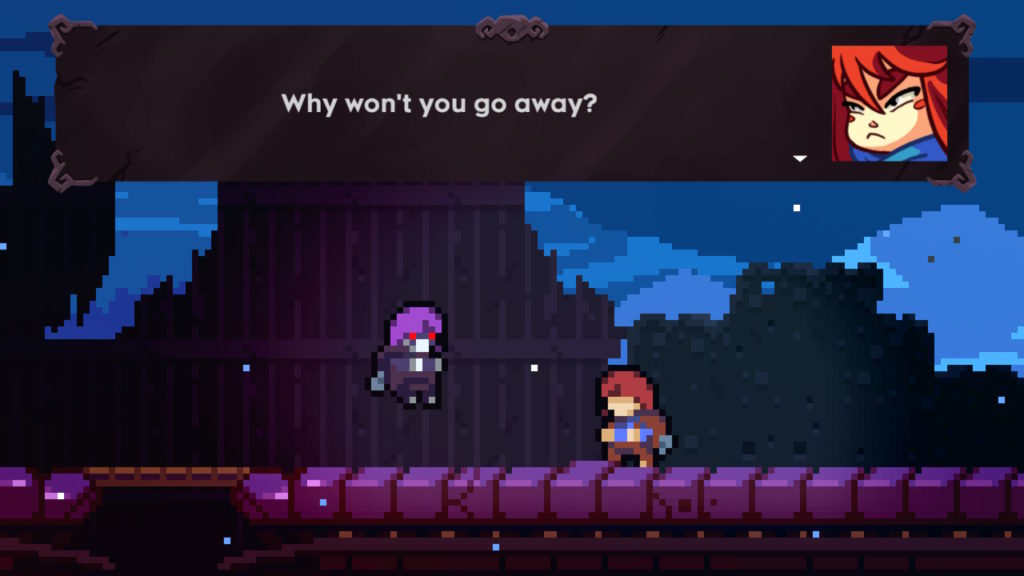
While journeying up the titular mountain, and fighting against her negative self, Madeline meets some interesting characters. Mr Oshiro is an insecure ghost who runs the abandoned hotel on Celeste Mountain, while Theo is another climber, who is a charismatic photographer trying to garner a following on the social media platform InstaPix (cute nod to Instagram). Each character in Celeste has interesting and charming dialogue, making the exchanges with characters enjoyable. If narratives aren’t what you’re after, dialogue and cutscenes can be skipped, but I implore you to listen to the story that Celeste wants to tell.
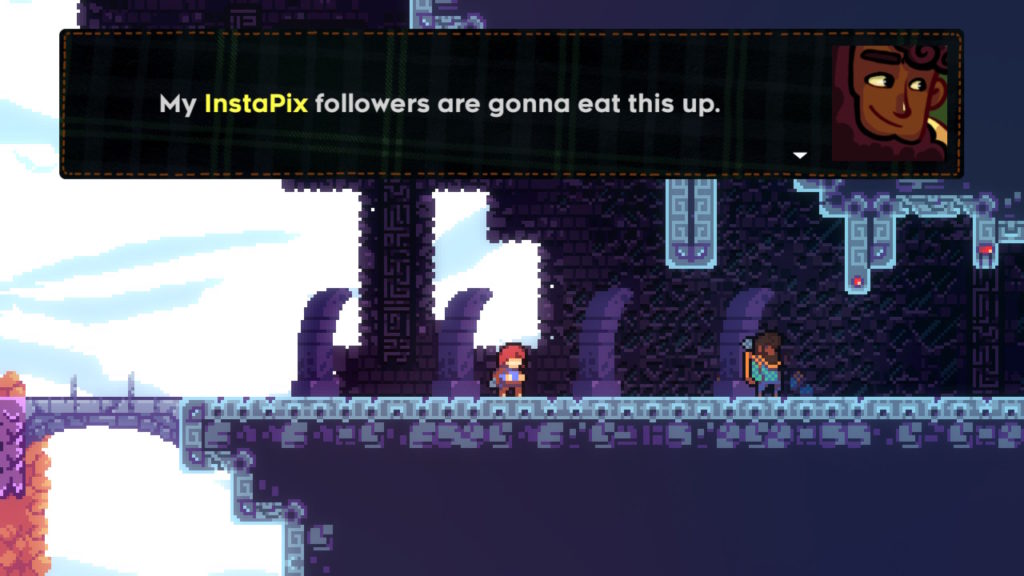
Celeste’s story is about overcoming obstacles and hardships in life, and that at the end of the day, if you believe in yourself, you’re more than capable of succeeding. The message of the story can be also be attributed to Celeste’s gameplay, as learning from your failures in each level is the key to progression.
Speaking of gameplay, Celeste’s is near perfect, offering up a challenge while also being fair to the player. The game can initially feel unfair, and deaths will undoubtedly hurt and frustrate, but they are almost always at the fault of the player, which is a testament to the game’s rock solid design. What aids Celeste’s brilliant gameplay is the fluidity of its movement, as traversing through the variety of environments on your journey to the peak of Celeste Mountain feels brilliant. The smoothness and ease of movement that the games mechanics provide allows the game to explore multiple different types of puzzle designs, with nothing feeling overly impossible to achieve with the tools you are given. Madeline can jump, dash and climb throughout her ascend of Celeste Mountain, with each mechanic having a limitation (must touch the ground to recharge dash ability etc). The mechanics and levels pair perfectly, maintaining a fair challenge throughout the entire journey. If things get tough, there’s an assist mode, that allows for tweaking of game speed, amount of air dashing etc. Celeste’s gameplay is remarkably refined as is, while still offering those who may struggle a way to cater the experience to their liking.
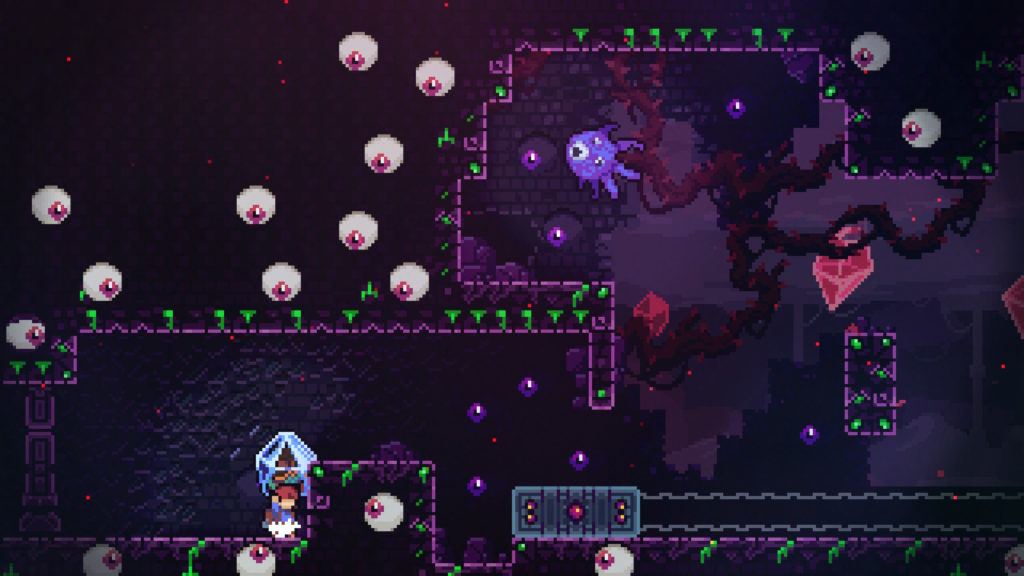
Each level in Celeste has its own distinct look and feel, from the to be expected snowy mountains, to a decrepit hotel and a long lost city. Each level also brings a new mechanic to the table, ensuring that there is always something fresh and new to encounter in each subsequent level. For example, one level has red tendrils sprouting from its floors and walls, that if touched, spout out a red tumor that will kill you if you have to touch it again. This mechanic eliminates the ability to backtrack, meaning you have to make the most of every step in order to progress. The variety in each level sets them apart, showing off Celeste’s sheer amount of creativity in its level design. The game’s levels each have distinct tasks required to progress, such as locating a key to unlock a door, but for those keen to stray off the beaten path, there are plenty of additional goodies to find.
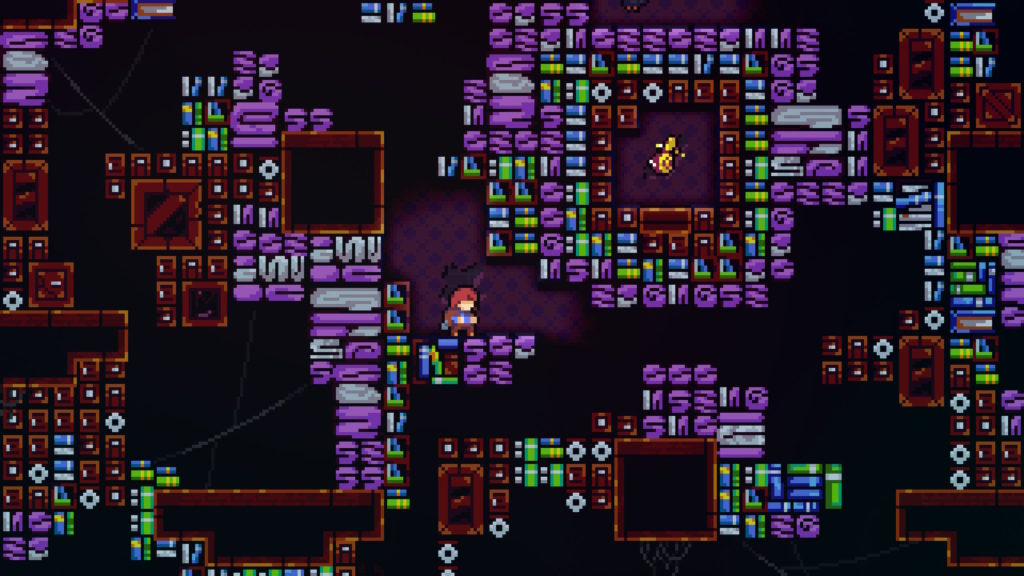
Strawberries serve as Celeste’s main form of collectible, providing a reward for completing optional rooms or finding hidden pathways. Strawberries provide no real reward at all, they simply serve as something to collect as a badge of honour, and despite not having a huge pay off for their collection, they had me hooked in my attempt to collect them all, which is a testament to how fun the challenges around them are. Strawberries aren’t the only special items you’ll find during your time with Celeste, as each level contains a particularly well hidden Cassette tape, which offer an alternate and far more difficult rendition of the level the tape was collected in. These alternate levels, known as B-Sides (cute cassette tape reference) provide Celeste’s true test, as they pose a far greater challenge than the already tough original levels. For example, in a single run of a B-Side level, I died 600 times, which was half the amount of deaths I accrued when playing through Celeste’s 7 main story chapters. The B-Sides are nice rewards for those keen to test their skills. Blue crystal hearts also appear in Celeste’s main chapters, with their collection allowing for access to a Chapter 8 after completing the main game. Overall, Celeste’s smooth gameplay and fun to obtain collectibles come together to provide a challenging but addictive gameplay experience that is hard to escape the grips of.

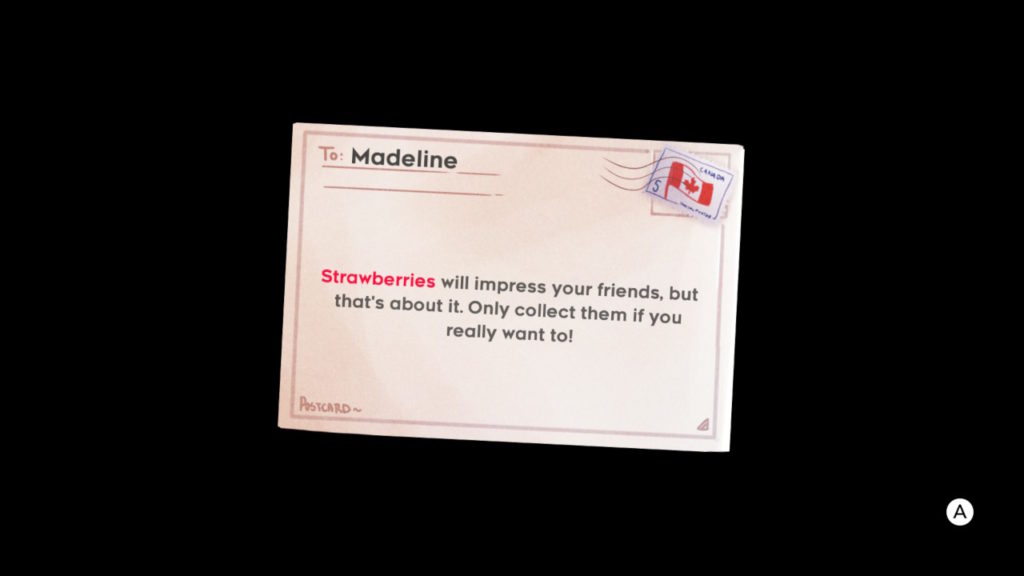
Celeste is arguably one of the greatest platformers ever created, masterfully pairing smooth and rewarding gameplay with a meaningful story with a strong message. The gameplay feels amazing to play and is always an enjoyable experience, the soundtrack aids the feeling of each level perfectly, and the narrative is both compelling and well executed, with a bunch of delightful characters featured throughout. Celeste is a lovable and addicting adventure, and a game I recommend that everyone experience at least once.
Celeste has been reviewed on the Nintendo Switch.
Mar 18, 2018News
Earthlock is a game heavily inspired by the JRPGs of yesteryear, attempting to provide a gameplay experience reminiscent to that of a PS1-era Final Fantasy game. Previously releasing on Xbox One and PC in 2016, and Wii U and PS4 in 2017 as Earthlock: Festival of Magic, Earthlock shakes off its old name, offering new features that the original release was sorely lacking. The new and improved version of Earthlock which has released first for Nintendo Switch is said to provide a better fleshed-out story, crafting, side quests and much more. Earthlock makes a decent attempt of replicating the magic of 90’s JRPGs, but the game’s myriad of problems prevent it from becoming a title worthy of comparison to the revered game it’s inspired from.
The story is set in the world of Umbra, a world that has been affected by a catastrophic event that has ceased the world from rotating (thus the title Earthlock). The horrible event, known by the people as the Deadly Halt, has left the world in disarray. Areas that were once livable have become uninhabitable deserts or have been shrouded in snow, leaving humanity to seek refuge in the areas free from the harsh conditions. The story centres on Amon, a desert scavenger, who after uncovering a mysterious artefact quickly finds himself in a spot of bother. His Uncle is kidnapped by a mysterious group who have an interest in the artefact, and Amon must find a way to reunite with his Uncle. Amon isn’t alone on his journey, with plenty of allies joining him along the way, such as the adorable Hogbunny Gnart Tigermoth as well as Ive Lavender, a rebellious soldier from the Great Wave, desperate to prove she’s more than the just the general’s daughter.
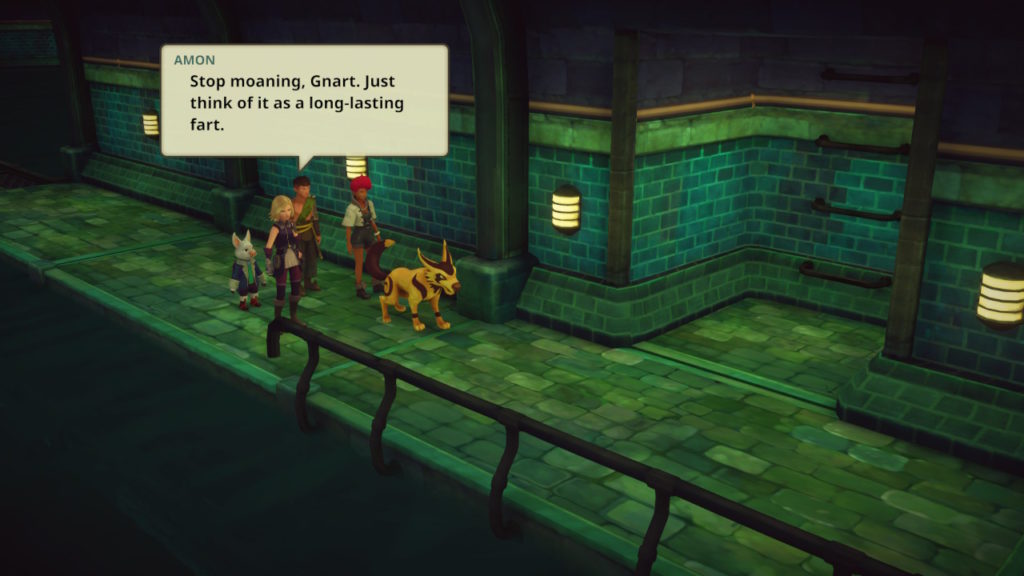
The characters that form your squad throughout the journey are quite enjoyable, despite being very cliched. Characters exchange the odd piece of witty dialogue, but they still felt rather bland most of the time, lacking the amount of character depth required for me to feel truly invested, which was truly a shame, as I really wanted to love the characters. The story does take a while to kick into gear, and even when the narrative began to get slightly more interesting, my lack of engagement with the world lead to myself feeling not a lot of interest. For those that do find enjoyment in the game’s world, there is a decent amount of lore to be found, I just never felt compelled enough to look for it. The characters are decent albeit generic, but the issues with the narrative and it’s pacing made it hard to remain invested.
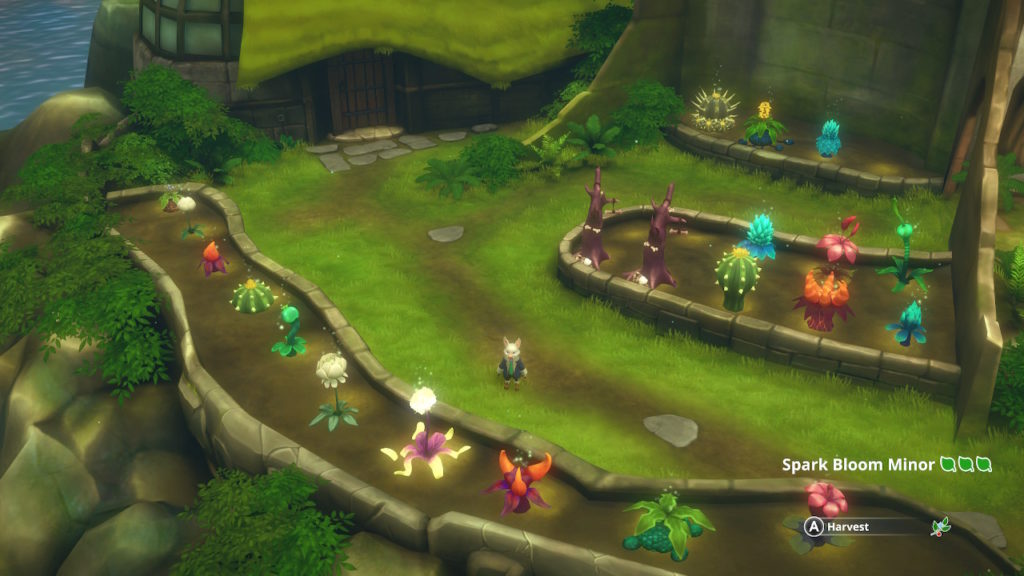
In terms of gameplay, Earthlock provides a turn-based system that occasionally shines, but more often than not is littered with minor annoyances. The combat despite its simplicity was often rather enjoyable, with more strategic combat than I thought there would be. Each character has two battle stances, which provide different ways to approach a battle. For example, Amon has a stance that focuses on melee attacks, and another stance that swaps the melee attacks for a spud gun that provides ranged combat options. The variety is appreciated, offering up different approaches to battles.
The ability to design your character’s talents using the talent point chart, and having characters bond over time to unlock special abilities were also aspects I enjoyed. In my playthrough for example, Amon and Gnart were inseparable, and when their bond meter reached max, Amon would be able to significantly damage the entire enemy squad, and then Gnart would heal him. Having six different characters to choose from to compile a team of four was also something I liked, as having the freedom of variety in your team composition could lead to a team that suits your style. The issues with the combat is how stale and repetitive it begins to feel, especially as the game progresses. This issue is further compounded by the overall slowness of the combat, as encounters seem to drag on far longer than they need to. Avoiding combat in a JRPG is an immediate bad sign, and during my time with Earthlock, I had periods where I’d attempt to avoid battles completely. I did find enjoyment in the game’s combat, but it does begin to get particularly grating.
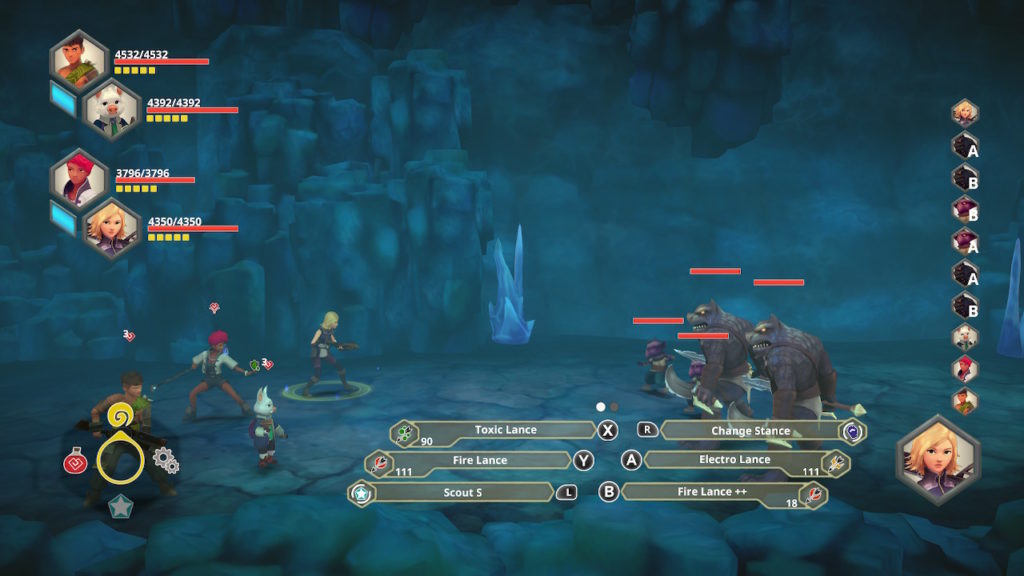
When you aren’t in combat, you’re free to travel the world of Umbra as you wish. There isn’t a great deal to do other than the stick to the story or fight random hordes of enemies, but there are a few other options, in the forms of side quests and crafting. The side quests throughout the game sadly feel like an afterthought, often requiring you to simply collect a certain amount of the required item, but the games crafting was surprisingly enjoyable. Unlike crafting games that make you wait significant periods of time, Earthlock allows you to plant seedlings and craft ammunition and potions from your collected materials almost immediately. I appreciated the simplicity of the crafting system, as it never felt overly menial.
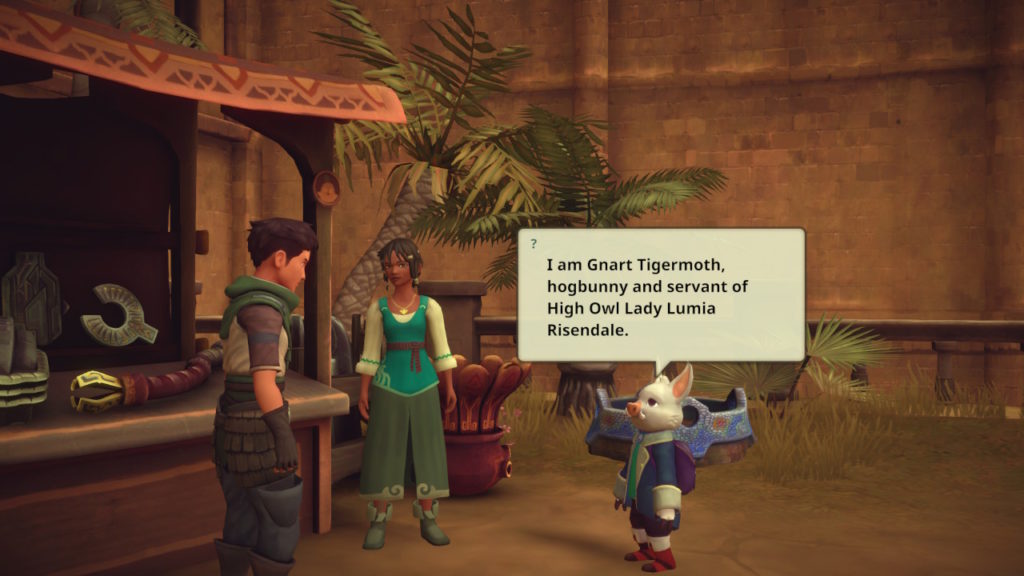
One of the most unforgiving issues I experienced during my time with Earthlock was the difficulty spikes that came out of nowhere numerous times. The game overall isn’t overly difficult, but the spikes that occurred multiple times completely ruined the flow of the game. Making your way through a dungeon with ease, and immediately becoming useless in the next area soured me so heavily that I at times turned the game off completely. JRPGs are known to require some amounts of grinding, but the amount of work required to become competitive again often didn’t feel worth it, with the last quarter of the game suffering from this issue significantly. It’s disappointing that the game is littered with these asinine difficulty spikes, as I’m sure it will be a reason that some will stop playing the game completely.
Overall, despite myself having a myriad of gripes with Earthlock, I did find it to be a rather good game. The combat had its moments, the story was serviceable, the characters are likeable, the music is great and the talent point system and crafting is fun to tinker with. Earthlock is a game I wanted to love, and despite the fact that it had its fair share of issues mainly was difficulty spikes and boring moments, I do believe it’s a game you should try if you have a strong love for 90s JRPGs. It may not match the quality of a Final Fantasy game, but it does offer up a decent JRPG experience.
Big thanks to Snow Castle Games for providing the Earthlock Switch Download Code for this review.
Feb 28, 2018News
Mulaka is a 3D action-adventure platformer about a Tarahumara warrior-sage known as the Sukuruame and his quest to stop the end of the world. You play as Mulaka, who wields a spear as his primary weapon and must make your way through various environments in order to prove your worth and enlist the help of the demigods. The game plays a lot like you might expect from Okami or Darksiders. However, the most notable thing about the game is its mission to teach players about the Tarahumara and their lore.
Of course, in any instance, focusing on one aspect of a game leaves room for flaws and gaps in another. In this case, we feel the story and lore focus of the game caused the gameplay to feel unpolished and somewhat lacking. Overall, Mulaka is a wonderful concept that seems to have just fallen short of its ambitions.
Gameplay and Mechanics
So as we stated, this is an action-adventure game. Mulaka really tries to balance exploration and combat. The combat is relatively simple and in a lot of situations, completely avoidable. You have a light attack and a heavy attack. There’s a dodge button, and of course, you can run and jump. Combining these makes for a few automatic combos and the occasional near miss of an attack. Unfortunately, as there’s no lock on to speak of, you’ll just keep missing some enemies altogether. Thankfully, your attacks usually have a really wide hitbox, so it rarely became a major issue.
Aside from this, there’s exploration to consider. In this regard, there seems to be plenty to keep an eye out for. In service of getting around, you have a few potions and transformations that will let you go places you couldn’t before. Of course, that led to an observation very early in the game that finding everything would absolutely require lots of backtracking, which it seems the game really wants the player to do, as some fights become very tedious later on without upgrades. You also have Sukuruame Vision, which allows you to see invisible enemies, NPCs, and track down points of interest. This usually floods your screen with objective markers, which is actually a bit overwhelming, at times. It can also help you seek out hidden objects that will give you a piece of lore for your troubles.
There’s also a light puzzle element introduced in the form of water puzzles. These puzzles are all fairly easy to figure out, though, and later in the game just become monotonous. It would’ve been nice to see more variety in the puzzles rather than just an increase in the size of the puzzles themselves.
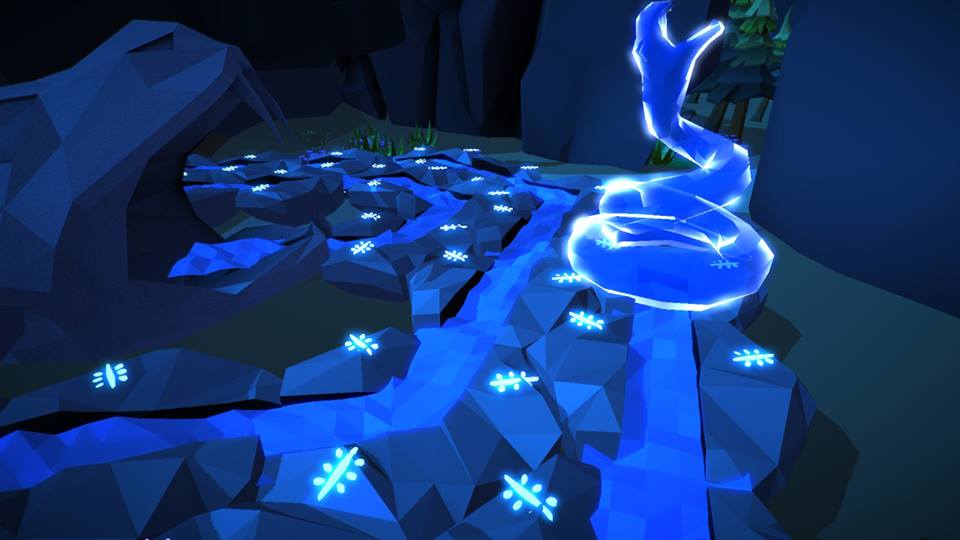
This is one of the later puzzles in the game. The solution is pretty obvious, but the puzzle still takes several minutes to complete.
Finally, there’s also a mechanic in the form of Korima, which works a lot like basic experience points. Korima embodies the thankfulness of the Sierra, which in turn translates to upgrades for Mulaka. However, there are only seven things to upgrade and they require a lot of Korima to do so, making it seem like too much trouble.
Mulaka’s lesser flaws
So there are other bothersome things present in this game. For one, the difficulty seem poorly curated, leading to an inconsistent curve. Some bosses later in the game are easier than some of the earlier ones and the final boss is much, much more difficult.
Also, when you lose a soul, Mulaka does a long animation where the soul is ripped from his body, but it seems he’s still vulnerable during this animation, meaning enough enemies can just chip away at your health and you can’t do anything about it. At one point, this led to us getting stun locked to death. Very frustrating.
This game also has some very wonky collision detection, which can be see while climbing just about any mountain wall. However, it was at its worst during a late game boss fight where you have to climb on the boss’s back in order to hit weak points up there. Even outside of that, though, it left an odd feeling like anytime I got somewhere, it felt as if I didn’t do it the intended way, even when it clearly was the intended path.
There’s also a balancing issue in combat where for the most part, the game gives you no reason not to run in and spam light attack until everything stops moving. There’s a few enemies that force you to use heavy attack, Sukuruame Vision, and even dodge in some rare occasions. However, it doesn’t really feel organic, so much as something you’re doing because you have no other choice.
Finally there was some issue with our game that caused frequent crashes. We don’t know if this is only on the Switch version, but it led to a few infuriating resets. Granted this was usually after a death, so we’re not sure how far back it really set us.
The Best Part About Mulaka
Finally, with all our nitpicking and gripes out of the way, we can get to what Mulaka is really about: the lore and the aesthetic. Mulaka uses a simplistic style to mimic the simple geometric drawings of the Tarahumara tribes. The story may follow the Sukuruame, but the lore is truly about a native American civilization in what is now New Mexico. Naturally, this means the main events of the game must also be from native lore, and so they are. The game even gives you a heaping does of legend in the exposition.
Aside from that, the music is actually really good and super interesting. We never entered a new area or a staged fight without noticing the music immediately. It really kept us going in a number of spots where the gameplay would’ve made us quit.
On top of that, there’s a great variety of levels. You travel from the desert into town. From there to the caverns by a river and then on towards the jungle. You even visit mountains the and underworld itself by the time you’re done. Every area feels similarly ancient and sacred. The team at Lienzo have certainly outdone themselves on this front.
Final Thoughts
Mulaka is a unique and interesting game. It’s difficult to recommend fully because the game is so unpolished and could easily lose many of its players because of it. However, we didn’t have a terrible time, outside of a few frustrating resets, and a few key aspects of the game kept us going. We greatly suggest giving this game a chance, if it sounds like your cup of tea. All judgements aside, we hope to see more from Lienzo, as we feel this game wasn’t too far off the mark for redemption.
Mulaka is currently available on PS4, Xbox One, and Steam, and will be available on Nintendo Switch beginning March 1st.
Special thanks to Lienzo for providing us with a review copy of Mulaka. This game has been reviewed using a pre-release download code of Mulaka – Nintendo Switch.
Feb 21, 2018News
Whether or not you’re a fan of retro-inspired games, you’ve probably heard of Owlboy before. After releasing on PC in 2016, Owlboy garnered universal acclaim and was touted as one of the greatest indie releases in the last five years. Now, just over a year on from its PC launch, the game has soared onto the Nintendo Switch (Owl pun), with PS4 and Xbox One versions not too far away.
Owlboy centres its story on Otus, a mute Owl who struggles to garner the acceptance of people around him. He finds himself scowled and mocked heavily, especially by Asio, his brutally negative mentor. The story sees Otus’ town attacked by Pirates, setting into motion a journey that will see Otus and friends along travel to many distant lands, in the hopes of stopping the sky-pirates from obtaining the three legendary relics and ruining their homeland. The basis of Owlboy’s storyline is undoubtedly video game story cliche, but somehow it manages to sprinkle in far more emotional storytelling than would initially be expected.
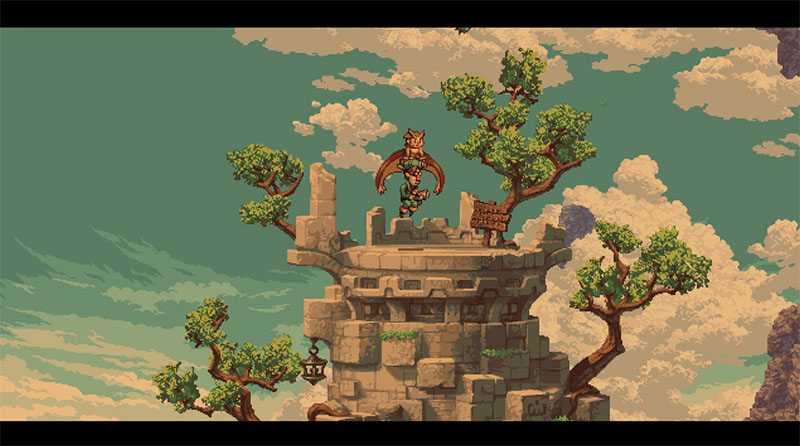
Owlboy is a game that addresses how people have self perceived flaws, and how, despite having weaknesses within themselves, the friends they have around them can make them feel like they belong. This is evident in Otus, with his struggles of being a mute, and how his best friend Geddy and his other buddies manage to give him strength and comfort in who he is. I won’t spoil any more of the story beats, but this game isn’t afraid to pile on you emotionally, as I found myself tearing up numerous times. With its fair share of epic and sad story moments, Owlboy’s narrative is a true highlight, and an aspect of the game I deem to be extremely important. The impact of the story was something that took me by complete surprise, leaving me heavily engaged, even after the credits had rolled. I do however wish the game didn’t end so abruptly, as the story ends leaving many questions unanswered. Even though it was obviously a decision to leave the ending of the story to interpretation, I wish I was given a more definitive ending.
Owlboy may have it’s slew of heartbreaking moments, but it also has plenty of joyous charm that emanates from the game’s humorous bunch of supporting characters. Otus is a sweet character that despite being unable to speak, provides plenty of character and humour with his variety of facial expressions, while his best pal Geddy is a goofy but caring mechanic, who wears his heart on his sleeve and isn’t afraid to express his opinion. Most characters throughout the game ooze personality and are a breath of fresh air in a genre where many characters can feel particularly stale and one-dimensional. Character dialogue had me chuckling aloud numerous times, which is a testament to how well the character dialogue has been written. Characters in Owlboy are yet another great strength that keeps Owlboy entertaining throughout.
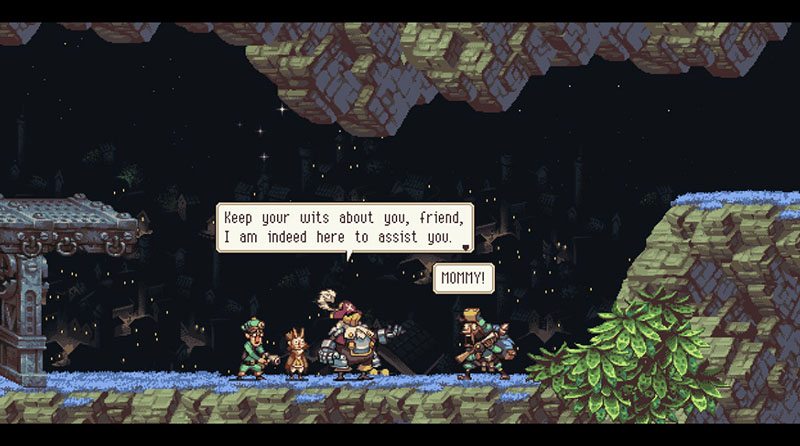
As Otus, you are pretty much given only a spin attack to keep enemies at bay. Otus, as indicated by his mentor Asio, isn’t particularly gifted, so his restricted moveset cleverly reinforces his character. In terms of flying, you’re pretty much free to do it uninhibited most of the time. There is no limit to flying, leading to the freedom of exploration, whilst alleviating the frustration of having to charge a flying meter. There are small segments throughout the game in which the ability to fly is taken away however, which leads to platforming segments that take away your comfort of control. Thankfully, these segments are well executed, leading to the type of quality platforming you’d expect from most other games in the genre.
Despite being unable to talk, Otus finds himself making friends, with these friends acting as individual abilities throughout the game. For example, Otus’ best friend Geddy acts as Otus’ method of attack, with Otus’ flying Geddy around while he shoots down enemies. The gameplay of all the friends throughout the journey is comparable to that of a twin-stick shooter. The shooting of enemies while flying around doesn’t at all feel complex, yet it still feels immensely rewarding to take out a multitude of enemies by spamming the trigger. As the game progresses and Otus makes new friendships, the new friends can be switched through on the fly (Owl pun) at almost any time. As to be expected from a game in the metroidvania genre, some areas can only be unlocked using certain abilities, with Alphonse’s shotgun allowing access to areas that Geddy’s blaster could not. Swapping through characters to ensure you have the right weapons at your disposal to progress through dungeons and defeat bosses can take a while to get comfortable with, but once you get ahold of the concept, it offers an interesting and enjoyable take on metroidvania progression.
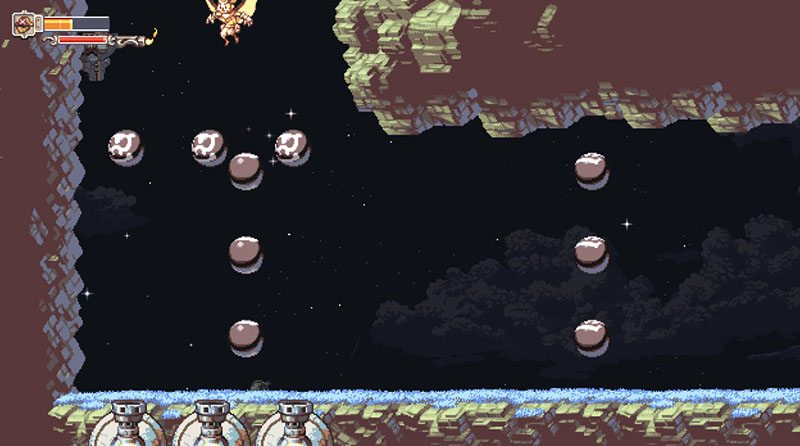
Graphically speaking, Owlboy’s pixel art aesthetic is in a league of its own, being arguably the most detailed and beautiful pixel art i’ve ever seen. The crisp animation looks jaw-dropping in both the Switch versions docked and handheld modes. The game’s highly publicised 9-year development cycle can truly be seen with the sheer quality of the games environmental and character designs. Characters exhibit a breathtaking amount of expression, both in body language and facial expressions. Otus’ face would turn from anger to shock, and in the games darker and more emotional moments, Otus’ body would slump, emphasising the gravity of what had occurred. The environments throughout the world are also extremely lively thanks to quality animation. Shrubs sway in accordance to the breeze, while the grass on the floor despite being so small in size can be seen moving with the wind also. The meticulous detail of Owlboys animation is something that arguably didn’t need to have been done, but the games world and characters are far more polished and expressive thanks to it.
The game’s soundtrack is also breathtaking, with numerous tracks providing great moments. Owlboy’s soundtrack has plenty of melodic tear-jerkers, as well as booming, epic beats, that always seem to perfectly fit in with the part of the game they are played in. My personal favorite would be the theme for the town of Tropos, with its epic piano and violin pieces being the perfect music to emanate Owlboy’s sense of adventure.

Despite being a brilliant 10 hour experience, Owlboy does have a small assortment of issues that did hinder my experience somewhat. When playing the game on the Nintendo Switch, I encountered about 5 crashes in my full playthrough. Some crashes were immediately after dying throughout the game, while other crashes seemingly occurred during the transitions from one area to another. Thankfully, the game autosaves frequently, meaning that not much, if any, progress is lost, but it’s still an annoyance nonetheless. I also encountered some heavy frame dropping in one of the game’s many boss battles, with the Lava Worm boss battle dropping performance to below 10fps when attacking. This was the only performance hiccup I recognised in my playthrough, but it was yet another frustrating issue, as I found it difficult trying to avoid attacks when the game would chug as badly as it did. These issues are simple fixes and will probably be removed in the coming weeks via patches, but it’s important to mention they do exist. It would’ve also been nice for the game to include a map feature, as it was hard to tell where I had and hadn’t backtracked.
Owlboy is overall a perfectly crafted Metroidvania experience that I implore everyone to play. The gameplay is tight and satisfying, the characters are sweet and charming, the story is remarkably deep and emotional, and the soundtrack ranges from beautiful and whimsical to booming and intense. Owlboy exudes polish and love, with D-Pad Studio managing to design a game that despite borrowing elements from games of the past, still feels remarkably fresh and modern. Owlboy is the complete package, and it offers up an experience that shouldn’t be missed.
Owlboy was reviewed on Nintendo Switch
Feb 11, 2018News
Rocket League’s premise is decidedly simple. Drive your high speed, rocket propelled car, and try and get the ball in the goal. Despite being such an uncomplicated game, Rocket League manages to provide brilliant gameplay that is easy to learn, but extremely difficult to master, as well as an amazing smorgasbord of different multiplayer modes. Driving the ball in to the goal is a simple enough task for anyone to achieve, however the game sports high-octane flipping and boosting that ensures that the game’s depth of strategy is far deeper than it’s initially perceived. Rocket League may have been available on other systems over 2 years ago, but with the Nintendo Switch version only releasing a few months ago, it’s time to have a look at how Rocket League stacks up on the latest Nintendo console.
Rocket League is certainly king when it comes to gameplay. The main gameplay mode, titled Soc-car (brilliant pun, I know) pits vehicle against vehicle in a game of a high speed, high action soccer. As mentioned prior, the premise of Soc-car is remarkably simple, score more goals than your opponent to win, sounds easy enough correct? The simplicity of Rocket League is arguably what makes it such a fun and addictive game, with the gameplay objectives being easy to pick up and play. In terms of gameplay, that’s basically it, but the gameplay is so expertly crafted that it never feels boring or monotonous.
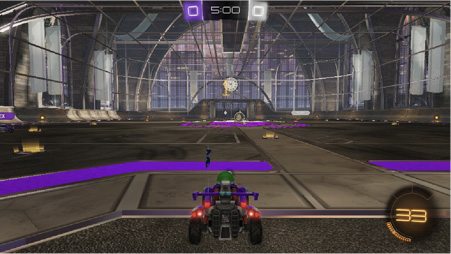
Soc-car is Rocket League’s main mode, and easily its best one
Soc-car isn’t the only gameplay mode on offer though, with various other modes available. Hoops mode converts Rocket League’s vehicular Soccer into a game of vehicular Basketball. Despite being not as fun as the game’s Soc-car mode, Hoops offers a mode that focuses more on keeping the ball in the air, with off-ground possession of the ball being the key to success. Hoops is undoubtedly a far weaker mode in Rocket League than Socc-car, but there is still plenty to be enjoyed in the Basketball themed mode. Snow Day is a mode that yet again changes Rocket League to different sport entirely, with Snow Day being a hockey mode. Snow Day succeeds in being a mode in which players can maintain control of the puck, as the predictability of a puck in comparison to a ball leads to far more controlled games. Being able to boost along the wall while maintaining easy control of the puck is a great feeling, and it was a great side mode that I spent lots of time in.
Rumble is a mode that resembles Mario Kart, with items being used on courses to add to an even more intense version of Soc-car. Every 10 seconds, players are given new items to use, such as a boxing glove that will propel the ball forward, or a disruptor which will cause an opponent’s car to accelerate uncontrollably. Rumble mode is hilarious fun that is best played with friends. The final mode, Dropshot, is a mode that involves hitting the ball into the floor of your opponents, in an attempt to break the floor and score a goal. Dropshot mode is all about maintaining control of the ball in the opposition’s side of the field, as once the floor has been destroyed enough, the goal is available. Dropshot is yet another great mode, being the most unique mode when compared to the other optional modes on offer. Offline play is a great time and the AI tends to be serviceable enough, although sometimes the AI can be a little dumb. If the ball is heading straight for the oppositions goal, they often just drive it right in to the goal. Offline play still provides plenty of hours of enjoyment, and despite the AI overall doing a good job its stupidity can be infuriating at times. The multiplayer is thankfully eons better, but we will get to that a bit later in the review. Overall, Rocket Leagues alternative modes are all great fun, and compliment the game’s already brilliant Soc-car mode.
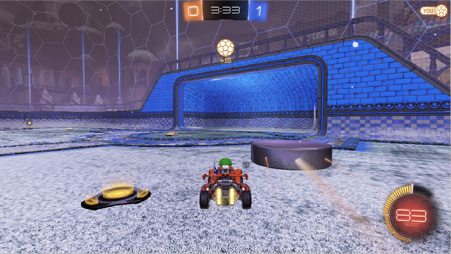
Snow Day is an example of one of Rocket League’s great alternative modes
Rocket League’s slew of modes can all be played with differing amounts of players in each side. 1v1 is a mode that is great if you have a score to settle with a friend, but otherwise it’s probably the least ideal mode to choose, as games can feel empty when you only have the singular opponent. 2v2 is also on offer, but the game truly hits its sweet spot in terms of balance when 3v3 matches take place. 3v3 matches nails the equilibrium of intensity and enjoyment, ensuring games flow at a good rate and aren’t too over crowded. 4v4 modes are ideal if you want a far more frantic experience, but I found myself constantly gravitating to the 3v3 games. Rocket League at least provides the option to players, granting them the freedom to find a mode and player count that suits them best.
Car customisation in Rocket League is full of options of things to tweak, from the obvious paint jobs and tyres, to the finer details such as how the engine sounds. Being the Nintendo version of Rocket League, there are a few Nintendo exclusive items, such as the Mario and Luigi hats, as well as system exclusive cars, such as the Mario NSR, Luigi NSR, and Samus’ Gunship. Customisable parts can be obtained simply by playing the game, with microtransactions involving loot boxes being your other way to get a hold of the game’s more unique and awesome loot. I didn’t feel the microtransactions were at all egregious, and despite their existence, they can easily be avoided. Rocket’s League’s customisation options are something I found heavily enjoyable, as it allows for users to design a car with their own distinct sense of personality and flair.
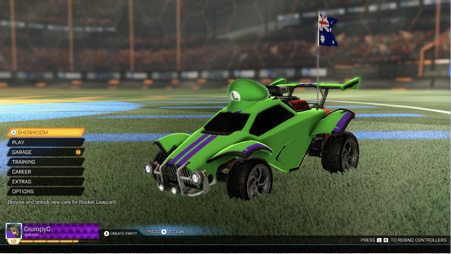
No other game lets me customize my car to highlight my love of Australia and Luigi simultaneously
Rocket League flaunts an abundance of different looking courses, some of which are exclusive to particular game modes. Courses all play relatively similar, however some have varied terrain which makes for a different gameplay experience. Rocket League’s courses all feature rather different aesthetics. One course sees you playing in an underwater arena, with a Shark and Stingray gliding in the water above, while another course, Neo Tokyo, as its name suggests, presents a futuristic, neon-clad Tokyo city arena. Some courses even sport alternative time of day and weather modes, further adding to the variety of course selection. Obviously, most of the courses do play the same, but it’s nice to have varied environments, as it saves the game from coming across as overly stale.
Rocket League’s multiplayer is the main reason to jump onboard and stick around, with all the modes available in the multiplayer playlists. Thanks to the cross-play collaboration with Xbox One and PC, Nintendo Switch users will never feel alone when it comes to finding other people online. If you don’t want to play against those on rivalling hardware for whatever reason, the option to turn off cross-play can be found in the options menu. I highly recommend keeping cross-play on however, as when searching exclusively for other Nintendo Switch users, I struggled to connect to games, and when I did, the other players were clearly from other parts of the world, and my online connection suffered. For the most part, I encountered little to no lag when playing online, something I’ve never been able to say I’ve experienced on a Nintendo system before.
Every once and while when playing online I’d encounter another Switch user, but most online games I found myself with Xbox or PC gamers, which I found hard having an issue with. After all, having cross-play means that the game will always be populated, and that’s never a bad thing.
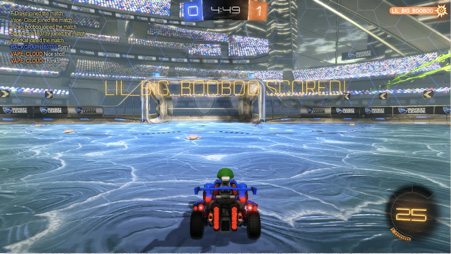
Seamless online multiplayer on the Switch is a beautiful sight
In terms of Nintendo Switch performance, Rocket League’s port is a little hit and miss. The game attempts to provide 720p 60fps in docked mode and 576p 60fps in handheld mode, with the dynamic resolution scaler making sure to drop the resolution in certain situations, to maintain the 60fps performance. As someone who prefers a game to run at a smooth 60fps, I’m perfectly fine with a game lessening it’s graphical fidelity, however, with Rocket League on Switch in docked mode, the game drops at times from a just passable 720p, to a far less forgivable 576p, which can look ugly when blown up on big TV displays. In the end, Rocket League manages to stay around the 60fps mark, but the game starts to progressively uglier as a result.
The game when in handheld mode, manages to hide most of its imperfections thanks to the far smaller display, but the game still struggles and looks quite jaggy and blurry. The games performance drops to around 40/50 frames when split screen is played, but it still manages to provide an enjoyable gaming experience. Performance wise, Rocket League on Switch is by no means brilliant, but I would say it’s still quite easily worth the purchase. Graphics may not be great, but the semi-reliable framerate paired with the ability to play portably offers a unique Rocket League experience that no other system can provide.
Performance will also improve later this spring, with Psyonix announcing updates will be brought to the system. Performance mode will offer 900p 60fps in docked mode and 720p 60fps in handheld mode. Quality mode will see docked mode maintain 1080p 30fps, with handheld mode aiming for 900p 30 fps.
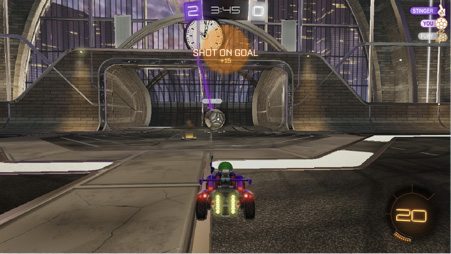
It may not be picturesque, but it sure is fun!
Rocket League on Nintendo Switch may be the ugly duckling of the Rocket League versions, but it still manages to provide a quality Rocket League experience that maintains the exact same available content as the rivalling console and PC versions. Panic Button, the studio tasked with porting Rocket League to Switch should be commended for their ability to bring an enjoyable, content-packed game like Rocket League to the Nintendo Switch. Rocket League on Nintendo Switch is a joy to play, with the games myriad of modes playable both offline and online, sure to keep fans of the game entertained for a long while yet.
Jan 27, 2018News
This review is based on the EARLY ACCESS version of My Time at Portia. New features and improvements are added to the game at a steady rate. All opinions and experiences are based on the current version of the game. A full Review with a final score will follow once the final version of My Time at Portia becomes available.
My Time at Portia is a game that is extremely difficult not to compare to games such as Stardew Valley, Harvest Moon and Animal Crossing.
The simulation RPG developed by Pathea games is a title that despite drawing comparisons to other games of the genre, manages to carve out its own unique experience that is certain to find a committed and hardcore fanbase. Despite only just releasing via Steam early access to the public, My Time at Portia is remarkably dense. Players can fish, farm, mine, build, converse with townsfolk, get married,fight bosses and traverse dungeons and with the game planning to remain in early access until fall of this year, it’s safe to say this isn’t all that players will be able to do.
The story begins with your character moving to the town of Portia to inherit your father’s decrepit old workshop in the hopes of restoring it to its former glory, it’s a simple premise that is short and sweet, quickly moving out of the players way to allow them to create their own narrative. Little tidbits of story regarding the world of Portia can be found if you look for them, and there are interesting side stories, such as the conflict between the Church and the Scientific Research Center.
The first thing you notice upon arrival is how beautiful and lively the the world of Portia is. The world of Portia is set in a post-apocalyptic future where human life is sparse and machines are simply relics of the past, but from how mystical and serene the world looks, it certainly doesn’t look like there has been an apocalypse. Portia is peaceful, colourful and beautiful in a way that reminds me of Studio Ghibli films such as Princess Mononoke and My Neighbor Totoro, with the world littered in lush forests with plenty of intriguing creatures that inhabit them. The attractive grassy landscape of Portia is juxtaposed by large monolithic structures that are remains of the old world. The music of My Time at Portia is also whimsical and calming, perfectly accompanying the tranquility of the games world. It’s truly an amazing and unique world.
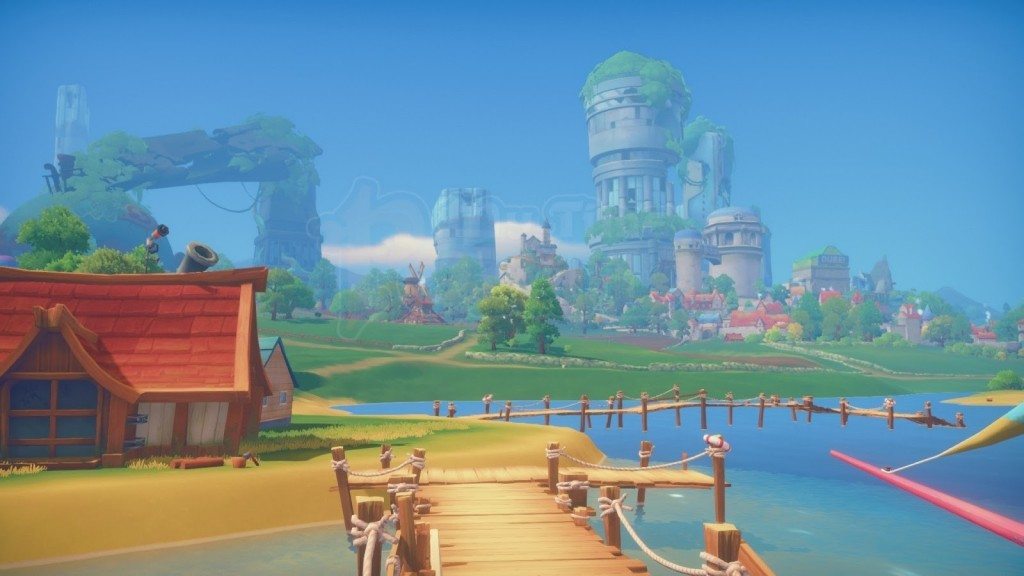
If this isn’t beautiful, than i don’t know what is
The town of Portia is full of interesting people to interact, and it’s entirely up to you if you want to take the time to build relationships with people. Some days i’d opt out of interaction with the townsfolk to spend a day focusing on building tools for my workshop, and on other days i’d forgo my crafting endeavours to try and build up some rapport with whoever I encountered in the village.The freedom to interact with characters however you like is an aspect of the game that i really appreciate.
Character Interaction is broken up into 4 options, Chat, Gift, Spar and RPS (Rock Paper Scissors) with each offering a way to build a relationship with the people of Portia. Chatting, sparring and play Rock Paper Scissors will slightly raise your relationship level, with gifting being the main way to win someone over (because who doesn’t like a nice gift?). Each character has distinct likes and dislikes, meaning you need to experiment or determine from their personality what they might like. I wanted to win over the town cat Pinky so I gave her a fish, I wanted to win over the Major’s cute daughter Ginger so I made her a Parasol because i’d seen her out in town with one before. The relationship system in the game is simplistic, yet fun enough to do that it makes me actively seek out conversation with the characters i want to befriend. The residents of Portia also live out their days in town realistically. When it’s time for school, kids are scurrying to school, and when it’s early in the morning Martha who runs the town bakery manages to do her morning exercise before she starts work. Characters even attend town meetings and festivals.The attention to detail in each character is evident, and really adds to the idea of Portia being a realistic, functional town.
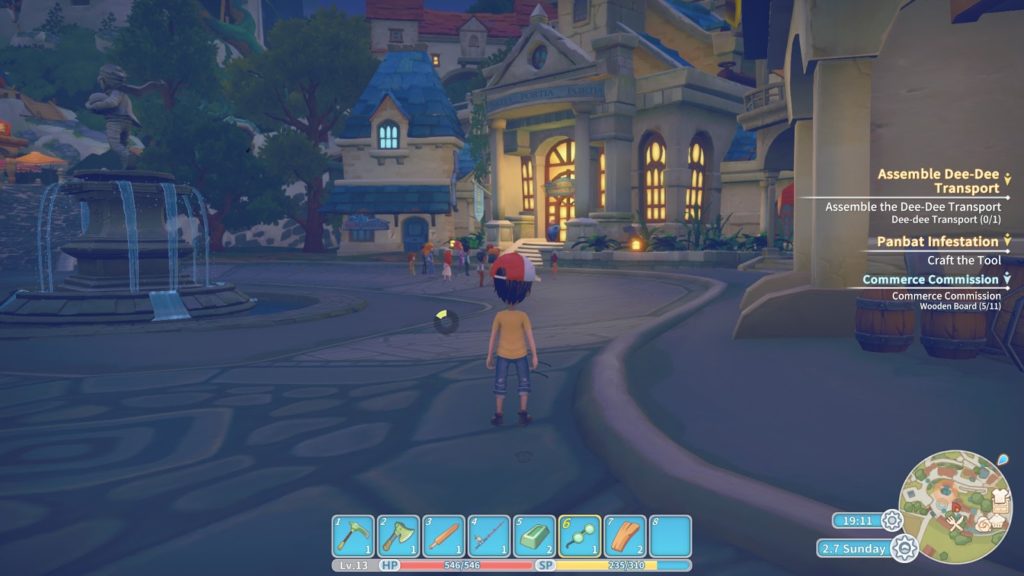
It appears I’m running late to the town meeting
When you aren’t chatting to people, you’re sure to be preoccupied by the rigours of running the workshop. My Time at Portia isn’t about the small satisfactions, it’s about working on the small incremental steps to achieve a well-deserved and rewarding goal. Much like other titles of a similar vein, most of your time in Portia will be spent grinding out what you need each day in order to complete commissions, which are essentially quests that can be collected from characters specifically, or via the commissions board in the Commerce Guild. Sure, some commissions can be achieved in a day, but most require a multitude of days of work, but the pay off for that hard work makes the gameplay loop extremely addictive.
I’ve never been a fan of having to methodically plan in games, but despite Portia requiring smart planning to ensure your days are well spent, I found myself rather comfortable and engaged with planning my days to be as efficient as possible. Most days will spent trying to mine as much ore as possible, while also making time to make efficient use of all the machinery at the workshop, such as utilizing the furnaces to smelt copper ore into copper bars or using the industrial cutter to ensure you have enough wooden boards. The mining despite being remarkably simple is really engaging, with plenty of resources to derive from Portia’s abandoned ruins. Simply whip out a pickaxe and mine whatever you like, or make use of your relic finder to find rare pieces of loot that remain from the old world.The fact that you can pick and choose how to approach each day in Portia is one of the games greatest strengths.
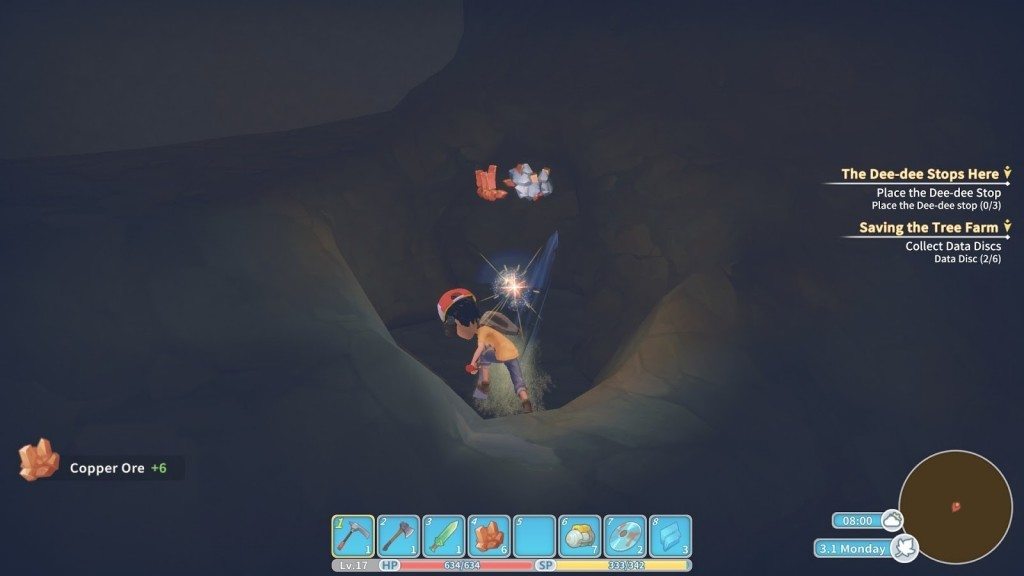
Mining is simplistic, but undoubtedly addictive
The games crafting system is multifaceted and despite being overwhelming at times, provides the player with a multitude of different things to create. The crafting in the early days is remarkably simple, but it quickly becomes far more intense. For example, to craft some of the game’s initial items, you simply need the items required and a single workshop table, however, as you complete commissions you are given lengthier and more difficult commissions that require the items to sometimes go through 3 different pieces of machinery.
Thankfully the crafting menus are simple to understand, but there are still some underlying problems. An issue I found was that you could accept commissions that require machinery that you do not own yet. This isn’t particularly a huge problem but it can easily lead to confusion as to why you can’t craft a particular item. Another minor gripe I have with the crafting is the timer on crafting items. It makes sense that in order to smelt ore into bars, that it may take some time, but as the game progresses to the point where you’re needing to manufacture dozens of bars for commissions, the time you have to wait starts to feel a little unnecessary, and it just lead to me putting my character to sleep to speed the in-game hours up. I may just be being extremely nitpicky, but I feel like this is something that should be fixed if possible in future updates. Regardless of the minor issues i find in the crafting system, i found the crafting in Portia constantly surprising me with the sheer amount of depth and options that it provides. Whether you want to build things for the Portian locals to make some money, or dedicate your resources to making a more efficient workshop, in the end it’s up to you.
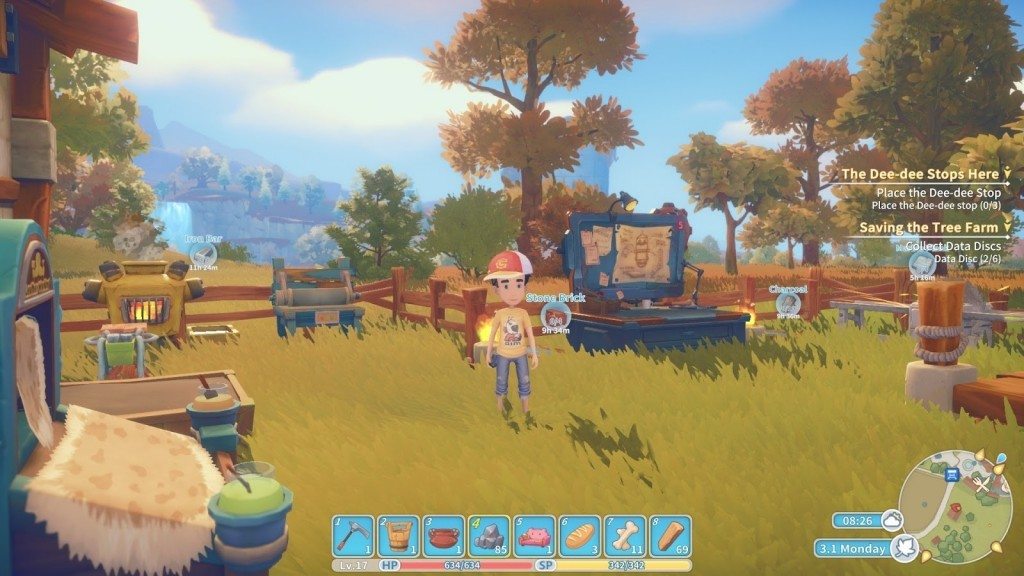
Making sure to efficiently use your workshop machinery is the key to success!
My Time at Portia has all the trappings of a great simulation RPG, however, the game’s shortcomings become more evident the longer you spend in the world of Portia. For example, the game’s combat despite being rather fun with it’s simple hack n’ slash gameplay falls apart in the game’s dungeon sections. A combat system that feels great when there are one or two enemies falls apart when you are swarmed by numerous enemy types in the dungeons. The dungeon’s bosses also feel remarkably unfair, with the primitive combat leading to trial and error that saps the enjoyment from the dungeon crawling experiences. I still highly enjoyed delving into the dungeons however, with the highlight of the dungeons being the platforming segments that reward rare items for straying off the beaten path. I’m sure that the issues with the combat will be noted and fixed in due time, but as of right now, they can be a little frustrating.
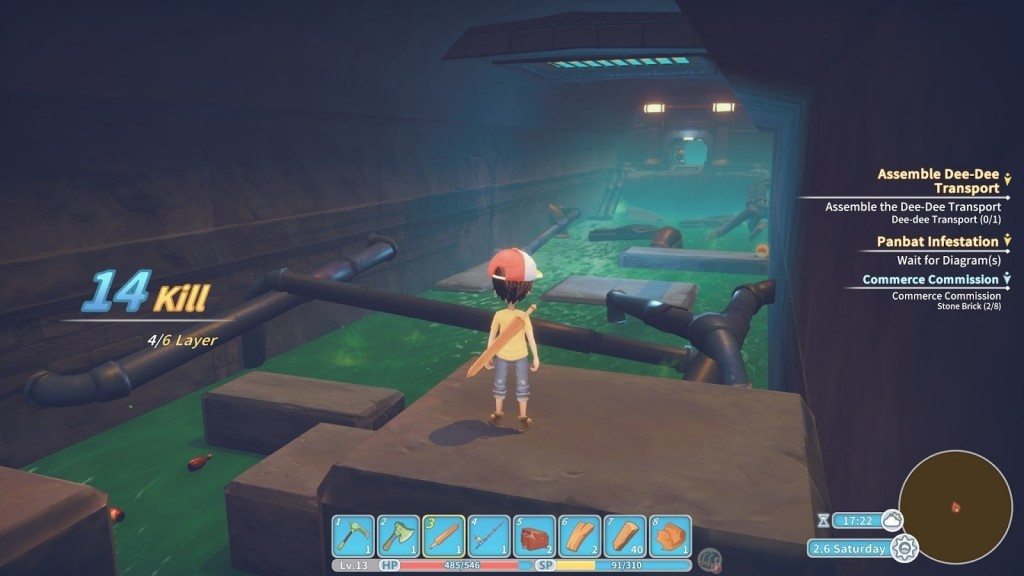
Exploration is the highlight of My Time at Portia’s dungeons
My Time at Portia at the end of the day is a good game that has all the foundations laid to make it a great game as the title progresses through it’s early access period. Despite being room for improvement (mainly with the combat and crafting systems), My Time at Portia is an extremely addictive and enjoyable simulation RPG that I believe is already well worth the price of admission. The world is beautiful, the characters are varied and interesting in their own unique ways, and there are a multitude of things to do. It’s always hard to judge a title when it isn’t entirely finished, but I do believe My Time at Portia will progressively become a better game as it nears the end of it’s development. Developer Pathea games has already indicated that new areas, commissions, side quests and more will be coming throughout the rest of the games development cycle, they even plan to add the ability to raise and ride animals. With more content on the horizon, as well as hopefully fixes for some of the issues I raised in this review, It seems obvious that My Time at Portia is only going to become an even greater game. For those wanting to jump in now, the game is available via Steam early access, with the planned full release slated for PC, Nintendo Switch, Playstation 4 and Xbox One later this year.
Giveaway
To enter the giveaway make sure you like this post on Facebook and leave a comment to let us know you want the download code for My Time at Portia! Winners will be randomly selected on January 29th. Best of luck!
Big thanks to Team 17 for providing the download code for the EARLY ACCESS version My Time at Portia!

